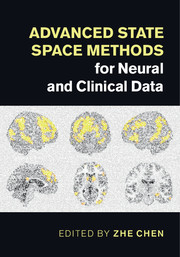Book contents
- Frontmatter
- Contents
- List of contributors
- Preface
- Introduction
- Inference and learning in latent Markov models
- Part I State space methods for neural data
- Part II State space methods for clinical data
- Bayesian nonparametric learning of switching dynamics in cohort physiological time series: application in critical care patient monitoring
- Identifying outcome-discriminative dynamics in multivariate physiological cohort time series
- A dynamic point process framework for assessing heartbeat dynamics and cardiovascular functions
- Real-time segmentation and tracking of brain metabolic state in ICU EEG recordings of burst suppression
- Signal quality indices for state space electrophysiological signal processing and vice versa
- index
- References
Signal quality indices for state space electrophysiological signal processing and vice versa
from Part II - State space methods for clinical data
Published online by Cambridge University Press: 05 October 2015
- Frontmatter
- Contents
- List of contributors
- Preface
- Introduction
- Inference and learning in latent Markov models
- Part I State space methods for neural data
- Part II State space methods for clinical data
- Bayesian nonparametric learning of switching dynamics in cohort physiological time series: application in critical care patient monitoring
- Identifying outcome-discriminative dynamics in multivariate physiological cohort time series
- A dynamic point process framework for assessing heartbeat dynamics and cardiovascular functions
- Real-time segmentation and tracking of brain metabolic state in ICU EEG recordings of burst suppression
- Signal quality indices for state space electrophysiological signal processing and vice versa
- index
- References
Summary
Background
Traditional approaches to physiological signal processing have focused on highly sensitive, and less specific detection techniques, generally with the expectation that an expert will overread the results and deal with the false positives. However, acquisition of physiological signals has become increasingly routine in recent years, and clinicians are often fed large flows of data which can become rapidly unmanageable and lead to missed important events and alarm fatigue (Aboukhalil et al. 2008).
Ignoring the nascent world of the quantified self for now, which itself has the potential to swamp medical practitioners with all manner of noise, there are two obvious examples of this paradigm. First, each intensive care unit (ICU) generates an enormous quantity of physiological data, up to 1GB per person per day (Clifford et al. 2009) More than 5 million patients are admitted annually to ICUs in the United States, with Europe and the rest of the world, rapidly catching up (Mullins et al. 2013; Rhodes et al. 2012). This can be attributed in part to the aging global population. ICU patients are a heterogeneous population, but all require a high level of acute care, with numerous bedside monitors. Patients in the ICU often require mechanical ventilation or cardiovascular support and invasive monitoring modalities and treatments (e.g., hemodialysis, plasmapheresis and extracorporeal membrane oxygenation). With an ever increasing reliance on technology to keep critically ill patients alive, the number of ICU beds in the US has grown significantly, to an estimated 6000 or more (Rhodes et al. 2012). Assuming an average ICU bed occupancy of 68.2% (Wunsch et al. 2013), the sum total of all bedside data generated in the US is over a petabyte of data each year. Multi-terabyte ICU databases are therefore becoming available (Saeed et al. 2011), and include parameters such as the ECG, the photoplethysmogram, arterial blood pressure and respiratory effort.
Information
- Type
- Chapter
- Information
- Advanced State Space Methods for Neural and Clinical Data , pp. 345 - 366Publisher: Cambridge University PressPrint publication year: 2015
References
Accessibility standard: Unknown
Why this information is here
This section outlines the accessibility features of this content - including support for screen readers, full keyboard navigation and high-contrast display options. This may not be relevant for you.Accessibility Information
- 3
- Cited by
